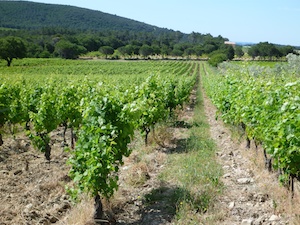The first of the tasks is the de-budding to remove all the excess buds and any unwanted shoots. De-budding generally takes place a few weeks after the bud burst. During pruning, a certain number of eyes are left on the branch, which represents the number of buds and branches that will form (see our post of pruning). However, sometimes more buds appear than were bargained for during pruning, which can increase the load on the vines and reduce the quality of the harvest. Studies have shown that de-budding improves the maturity of raisins at harvest time by increasing the sugar levels, and thus the potential alcoholic volume. De-budding is a purely manual task. There is no machine capable of removing the buds without harming the plant.
We also remove the buds and shoots from the base and trunk of the vines. This is known as "epamprage" and can be done manually or mechanically using a tractor with rotating axels that brush the vines and remove the unwanted growth. Epamprage can also be conducted chemically with contact products or by using heat to burn the new shoots. Empamprage is often conducted at the same time as the soil is turned to remove grass and weeds.

The remaining shoots on the vines will then continue to grow, and from May to July comes the moment to raise the training wires in the vineyards. As the vines grow, the wires are raised and fixed to the posts, a task that usually requires several passes. We make sure that all of the branches grow between the two training wires so that the weight of the leaves and fruit are better supported. To help avoid the branches falling back down, the wires are clipped together. The branches are spaced apart to let the air better circulate and the sun to reach the leaves. This also helps the tractors to pass freely in the vineyard without damaging the vines and to improve the efficiency of any treatments.
At the same time as working on the vines, the winemaker also works the soil from April onwards to air the soil, let in more warmth, and to keep the growth of grass and weeds in check.
The next tasks for the winemaker in the vineyard will be to control the growth between the leaves, branches and fruit, jobs that we will explain in more detail soon.
More articles on the work in the vineyard :
Comments
-
I loved it and the wine is excellent! What a great day!
Adopted mother of vines for the 2011 vintage at Château Beau Rivage)





Envoyé le Mardi 06 May 2014 by Josiane M.